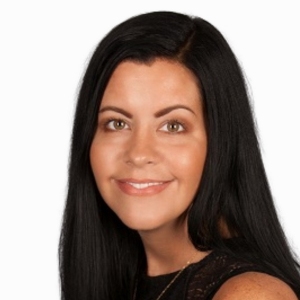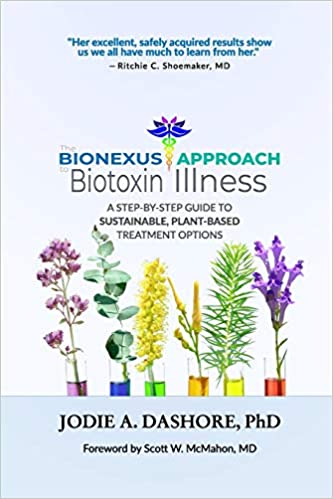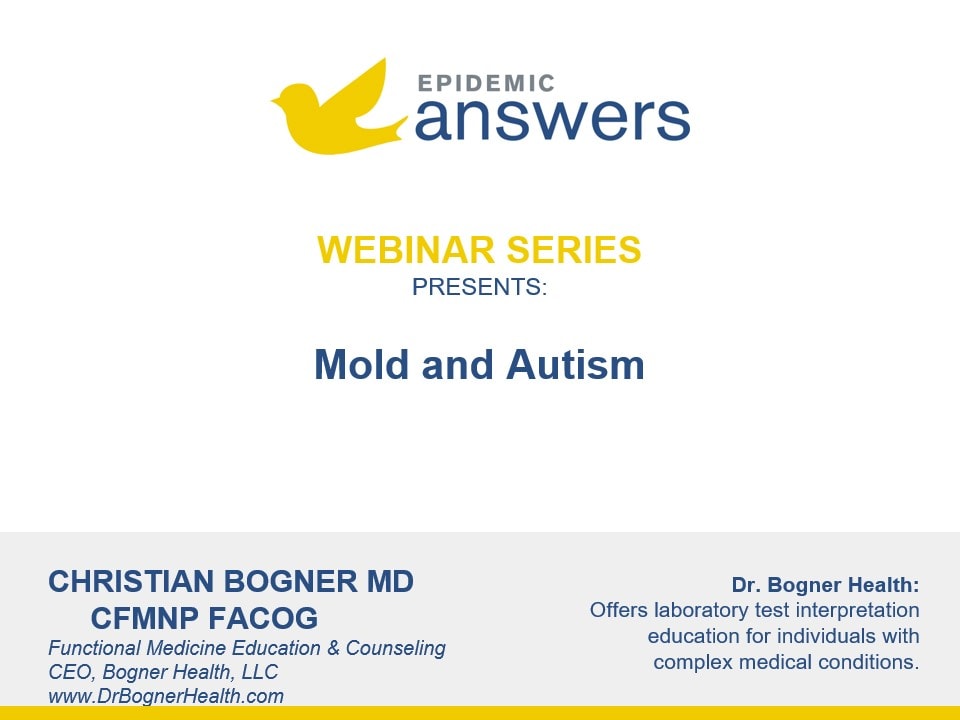We interviewed PJ Harlow, an IICRC-certified holistic mold consultant, about mold in the home and how it affects health. You can watch the replay below. Please note that you will be asked to provide your email address at the 30-minute mark to continue viewing the replay.
Is Mold in the Home Really All That Bad?
Yes, it can be! Water damage and humidity inside the home can cause mold to grow in your home, especially in dark and damp locations such as damaged drywall behind and under sinks. Mold fragments and mycotoxins can cause systemic inflammation and immune dysregulation, particularly in those with a high total load and/or genetic susceptibility.
Children with intractable autism, ADHD, Sensory Processing Disorder, learning disabilities, developmental delays, PANS/PANDAS, other neurological conditions, asthma, allergies, autoimmune conditions and even emotional/behavioral conditions often cannot completely heal due to unknown mold exposure at home or at school. In our experience, if your child has hit a healing plateau, it is helpful to work with a Bau biologist or holistic mold consultant to identify sources of mold exposure.
In This Webinar
PJ Harlow helped us to answer the following questions in this webinar:
- What are some signs, symptoms and common diagnoses associated with mold and mycotoxin illness?
- Is everyone affected equally by mold and mycotoxins?
- What are some underlying conditions in the home that can contribute to mold proliferation?
- Why is mold contamination at such an epidemic in homes and schools?
- What kind of tests should be run for suspected mold contamination?
- What if mold tests come back normal?
- What is the best way to remediate mold in the home?
- Is bleach the best for getting rid of mold?
Key Discussions
Home Microbiome and Mold Exposure
The health of the indoor environment is deeply connected to the diversity and balance of its microbiome, including its mycobiome. The natural presence of mold is part of this system, and maintaining a diverse range of bacteria and other microorganisms is beneficial for immune system health of the house as well as the people living in it. Water damage in the home, the use of modern construction materials such as drywall, and the impact of glyphosate on soil diversity can contribute to dormant mold issues in the home.
Mold Testing and Inspection
PJ advised that tests like an ERMI, endotoxin test and air sampling should complement a trained expert’s visual inspection. Inspection and remediation processes require specialized knowledge, which is often missing in mold-remediation companies. For those inspecting potential homes to purchase, focus on basements, attics and crawl spaces and using tools like moisture meters are recommended. It is difficult, yet critical, to find qualified and effective inspectors and remediators.
Mold Remediation and Effective Cleaning
Proper mold remediation is a complex process that requires professional expertise, caution against the use of harsh chemicals such as bleach, and a focus on layered cleaning practices. It involves not just the removal of mold but also addressing the underlying moisture problems to prevent recurrences. Focus on the moisture, not the microbe.
Individual Health and Susceptibility
Different individuals react to mold exposure in varying ways, impacted by the total load of genetics (such as HLADR or MTHFR mutations), overall health, and lifestyle factors including stress and diet. This means that medical and remediation approaches should be personalized and that taking care of one’s immune system through various health strategies is critical in reducing susceptibility to mold-related illnesses such as CIRS, MARCONS, autism, asthma, allergies, autoimmune disorders, mood disorders and PANS/PANDAS.
Psychological and Social Impacts of Mold
Mold issues in a home can have significant emotional and social consequences, including marital stress, feelings of isolation, and the dilemma of managing both mold remediation and maintaining family-life balance. Understanding the mental and emotional toll of mold exposure is important in providing holistic support to affected individuals and families.
Timestamped Overview
00:00 Abandoned home due to dangerous mold infestation.
20:02 Assessing susceptibility to environmental factors and conditions.
31:12 Identifying and addressing mold issues is complicated.
35:09 Difficulty finding qualified providers leads to problems.
49:35 Balanced home microbiome promotes better health.
01:02:21 An ERMI test should be interpreted professionally, with at least a 30-minute consultation. Beware of misinterpretation, which is common.
01:06:45 Clean holistically, using natural products and steam in a layered process.
01:20:01 Question about mycotoxin urine test.
01:33:09 Create air exchange by opening windows daily.
01:40:23 Created free Instagram chart for selecting air purifiers.
01:54:21 Consider health and duration before enduring discomfort.
02:01:28 Replace air filters regularly based on type.
About PJ Harlow CHHP TCST UFT
PJ Harlow is the proprietor and chief executive officer of PJ Harlow Wellness, Inc., a virtual, IICRC-certified holistic mold consultancy.
She is a certified holistic health practitioner whose primary role is as a holistic mold consultant specialized in working with health-conscientious property owners who have encountered indoor mold, mycotoxin and water-damage-contamination exposure.
PJ is a visionary pioneer in the field of holistic mold consulting. She is known for her forthright work ethic, pragmatic approach to consulting, and deep knowledge of the mold industry’s underbelly.

She has seen things that few professionals have ever seen, and she has been privileged to receive invaluable feedback from her thousands of cases. She uses this knowledge to help her current clients make informed decisions about their mold remediation & home’s health.
A staunch advocate for her clients, PJ will always fight for their best interests. You can find out more about her and her work at her website https://pjharlowwellness.com
Disclaimer
This webinar is not a substitute for medical advice, treatment, diagnosis, or consultation with a medical professional. It is intended for general informational purposes only and should not be relied on to make determinations related to treatment of a medical condition. Epidemic Answers has not verified and does not guaranty the accuracy of the information provided in this webinar.
Still Looking for Answers?
Visit the Epidemic Answers Practitioner Directory to find a practitioner near you.
Join us inside our online membership community for parents, Healing Together, where you’ll find even more healing resources, expert guidance, and a community to support you every step of your child’s healing journey.
Sources & References
Baker, S., et al. Case Study: Rapid Complete Recovery From An Autism Spectrum Disorder After Treatment of Aspergillus With The Antifungal Drugs Itraconazole And Sporanox. Integr Med (Encenitas). 2020 Aug;19(4):20-27.
Bennett, J.W., et al. Mycotoxins. Clinical Microbiology Reviews. Jul 2003: 497-516.
Berndtson, K., et al. Medically sound investigation and remediation of water-damaged buildings in cases of CIRS-WDB. Center for Research on Biotoxin Associated Illness. 2016 Jan 19.
Berry, Y. A Physician’s Guide to Understanding and Treating Biotoxin Illness. 2014.
de Allori, M.C.G., et al. Antimicrobial resistance and production of biofilms in clinical isolates of coagulase-negative Staphylococcus strains. Biol Pharm Bull. 2006 Aug;29(8):1592-6.
De Santis, B., et al. Role of mycotoxins in the pathobiology of autism: A first evidence. Nutr Neurosci. 2019 Feb;22(2):132-144.
De Santis, B., et al. Study on the Association among Mycotoxins and other Variables in Children with Autism. Toxins (Basel). 2017 Jun 29;9(7):203.
Hope, J. A review of the mechanism of injury and treatment approaches for illness resulting from exposure to water-damaged buildings, mold, and mycotoxins. ScientificWorldJournal. 2013 Apr 18;2013:767482.
Hudnell, H.K. Chronic biotoxin-associated illness: multiple-system symptoms, a vision deficit, and effective treatment. Neurotoxicol Teratol. Sep-Oct 2005;27(5):733-43.
Institute of Medicine (US) Committee on Damp Indoor Spaces and Health. Damp Indoor Spaces and Health. Washington (DC): National Academies Press (US); 2004.
Kali, A. Antibiotics and bioactive natural products in treatment of methicillin resistant Staphylococcus aureus: A brief review. Pharmacogn Rev. Jan-Jun 2015;9(17):29-34.
Kontoyiannis, D.P., et al. Treatment principles for the management of mold infections. Cold Spring Harb Perspect Med. 2014 Nov 6;5(4):a019737.
Oliva, A., et al. High Potency of Melaleuca alternifolia Essential Oil against Multi-Drug Resistant Gram-Negative Bacteria and Methicillin-Resistant Staphylococcus aureus. Molecules. 2018 Oct 9;23(10):2584.
Ratnaseelen, A.M., et al. Effects of Mycotoxins on Neuropsychiatric Symptoms and Immune Processes. Clin Ther. 2018 Jun;40(6):903-917.
Salari, M.H., et al. Antibacterial effects of Eucalyptus globulus leaf extract on pathogenic bacteria isolated from specimens of patients with respiratory tract disorders. Clin Microbiol Infect. 2006 Feb;12(2):194-6.
Shoemaker, R.C., et al. Sick building syndrome (SBS) and exposure to water-damaged buildings: time series study, clinical trial and mechanisms. Neurotoxicol Teratol. Sep-Oct 2006;28(5):573-88.
Shoemaker, R.C., et al. Structural brain abnormalities in patients with inflammatory illness acquired following exposure to water-damaged buildings: a volumetric MRI study using NeuroQuant®. Neurotoxicol Teratol. Sep-Oct 2014;45:18-26.
Shoemaker, R.C., et al. A time-series study of sick building syndrome: chronic, biotoxin-associated illness from exposure to water-damaged buildings. Neurotoxicol Teratol. Jan-Feb 2005;27(1):29-46.
Resources
Dashore, Jodie. The BioNexus Approach to Biotoxin Illness. Blurb, 2020.
Shoemaker, Ritchie MD, et al. The Art and Science of CIRS Medicine. BookBaby, 2020.
Shoemaker, Ritchie MD, et al. Surviving Mold: Life in the Era of Dangerous Buildings. Otter Bay Books, 2010.
Vetter, Paula. Mold Illness: Surviving and Thriving: A Recovery Manual for Patients & Families Impacted By CIRS. BookBaby, 2018.
Websites
Tests
Great Plains Laboratory MycoTOX Profile
Videos
The Great Plains Laboratory: Autism and Mold Exposure: Why Testing for Mycotoxins is So Important



